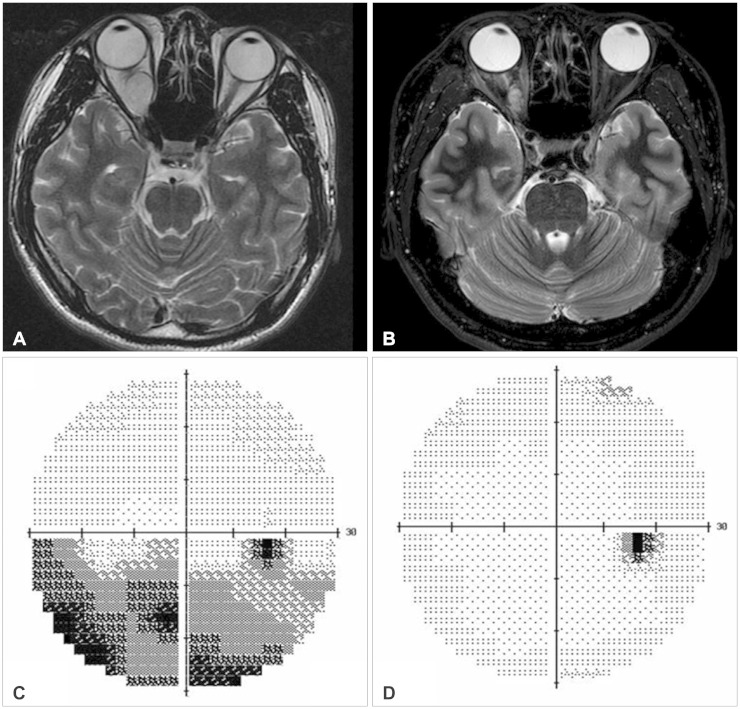Brain Tumor Res Treat.
2014 Oct;2(2):56-61. 10.14791/btrt.2014.2.2.56.
Fractionated Gamma Knife Radiosurgery for Benign Perioptic Tumors: Outcomes of 38 Patients in a Single Institute
- Affiliations
-
- 1Department of Neurosurgery, Samsung Medical Center, Sungkyunkwan University School of Medicine, Seoul, Korea. jilee@skku.edu
- KMID: 2134272
- DOI: http://doi.org/10.14791/btrt.2014.2.2.56
Abstract
- BACKGROUND
This study was performed to evaluate the efficacy and safety of fractionated Gamma Knife radiosurgery (GKRS) for perioptic lesions.
METHODS
Thirty-eight patients with perioptic tumors were treated at our institute from May 2004 to December 2008. All patients had a lesion in close contact with the optic apparatus. Twenty-four of these patients had undergone surgical resection before fractionated GKRS. Radiation was delivered in four sessions with 12 hours intervals between sessions. The mean target volume was 3,851 mm3 and the median cumulative marginal dose was 20 Gy. The median follow-up was 38.2 months. Visual acuity and visual fields were analyzed according to visual impairment score using the German Ophthalmological Society guidelines.
RESULTS
Tumor control was achieved in 35 (94.6%) of the 37 patients with available follow-up images. Progressive tumor growth was observed in two craniopharyngioma patients (5.4%). Favorable visual outcomes in the postoperative period were achieved in 94.7% of cases (36/38). Sixteen patients showed visual function after fractionated GKRS, twenty cases were stationary, and two patients showed visual function deterioration after GKRS.
CONCLUSION
GKRS is a safe and effective alternative to either surgery or fractionated radiotherapy for selected benign lesions that are adjacent to the optic apparatus.
Keyword
MeSH Terms
Figure
Reference
-
1. Adler JR Jr, Gibbs IC, Puataweepong P, Chang SD. Visual field preservation after multisession cyberknife radiosurgery for perioptic lesions. Neurosurgery. 2006; 59:244–254. discussion 244-54. PMID: 16883165.
Article2. Borden JA. Treatment of tumors involving the optic nerves and chiasm. Semin Ophthalmol. 2002; 17:22–28. PMID: 15513452.
Article3. Andrews DW, Faroozan R, Yang BP, et al. Fractionated stereotactic radiotherapy for the treatment of optic nerve sheath meningiomas: preliminary observations of 33 optic nerves in 30 patients with historical comparison to observation with or without prior surgery. Neurosurgery. 2002; 51:890–902. discussion 903-4. PMID: 12234395.
Article4. Friedman WA, Foote KD. Linear accelerator radiosurgery for skull base tumors. Neurosurg Clin N Am. 2000; 11:667–680. PMID: 11082177.
Article5. Estrada J, Boronat M, Mielgo M, et al. The long-term outcome of pituitary irradiation after unsuccessful transsphenoidal surgery in Cushing's disease. N Engl J Med. 1997; 336:172–177. PMID: 8988897.
Article6. Lee M, Kalani MY, Cheshier S, Gibbs IC, Adler JR, Chang SD. Radiation therapy and CyberKnife radiosurgery in the management of craniopharyngiomas. Neurosurg Focus. 2008; 24:E4. PMID: 18447743.
Article7. Pollock BE. Stereotactic radiosurgery of benign intracranial tumors. J Neurooncol. 2009; 92:337–343. PMID: 19357960.
Article8. McCord MW, Buatti JM, Fennell EM, et al. Radiotherapy for pituitary adenoma: long-term outcome and sequelae. Int J Radiat Oncol Biol Phys. 1997; 39:437–444. PMID: 9308948.
Article9. Movsas B, Movsas TZ, Steinberg SM, Okunieff P. Long-term visual changes following pituitary irradiation. Int J Radiat Oncol Biol Phys. 1995; 33:599–605. PMID: 7558949.
Article10. Paek SH, Downes MB, Bednarz G, et al. Integration of surgery with fractionated stereotactic radiotherapy for treatment of nonfunctioning pituitary macroadenomas. Int J Radiat Oncol Biol Phys. 2005; 61:795–808. PMID: 15708259.
Article11. Metellus P, Regis J, Muracciole X, et al. Evaluation of fractionated radiotherapy and gamma knife radiosurgery in cavernous sinus meningiomas: treatment strategy. Neurosurgery. 2005; 57:873–886. PMID: 16284558.
Article12. Kim JW, Im YS, Nam DH, Park K, Kim JH, Lee JI. Preliminary report of multisession gamma knife radiosurgery for benign perioptic lesions: visual outcome in 22 patients. J Korean Neurosurg Soc. 2008; 44:67–71. PMID: 19096695.
Article13. Fahlbusch R, Schott W. Pterional surgery of meningiomas of the tuberculum sellae and planum sphenoidale: surgical results with special consideration of ophthalmological and endocrinological outcomes. J Neurosurg. 2002; 96:235–243. PMID: 11838796.14. Barbaro NM, Gutin PH, Wilson CB, Sheline GE, Boldrey EB, Wara WM. Radiation therapy in the treatment of partially resected meningiomas. Neurosurgery. 1987; 20:525–528. PMID: 3587542.
Article15. Goldsmith BJ, Wara WM, Wilson CB, Larson DA. Postoperative irradiation for subtotally resected meningiomas. A retrospective analysis of 140 patients treated from 1967 to 1990. J Neurosurg. 1994; 80:195–201. PMID: 8283256.16. Taylor BW Jr, Marcus RB Jr, Friedman WA, Ballinger WE Jr, Million RR. The meningioma controversy: postoperative radiation therapy. Int J Radiat Oncol Biol Phys. 1988; 15:299–304. PMID: 3403313.
Article17. Salinger DJ, Brady LW, Miyamoto CT. Radiation therapy in the treatment of pituitary adenomas. Am J Clin Oncol. 1992; 15:467–473. PMID: 1449108.
Article
- Full Text Links
- Actions
-
Cited
- CITED
-
- Close
- Share
- Similar articles
-
- Preliminary Report of Multisession Gamma Knife Radiosurgery for Benign Perioptic Lesions: Visual Outcome in 22 Patients
- How to use Leksell GammaPlan
- Exponential growth of an asymptomatic meningioma responsive to fractionated Gamma Knife radiosurgery
- Postoperative Residual Juvenile Nasopharyngeal Angiofibroma Treated with Gamma Knife Surgery
- Normal pressure hydrocephalus after gamma knife radiosurgery in a patient with vestibular schwannoma


